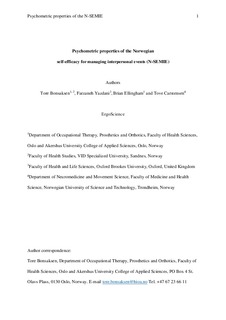| dc.contributor.author | Bonsaksen, Tore | |
| dc.contributor.author | Yazdani, Farzaneh | |
| dc.contributor.author | Ellingham, Brian | |
| dc.contributor.author | Carstensen, Tove | |
| dc.date.accessioned | 2019-04-29T12:30:18Z | |
| dc.date.available | 2019-04-29T12:30:18Z | |
| dc.date.created | 2018-01-11T14:18:20Z | |
| dc.date.issued | 2018 | |
| dc.identifier.citation | Ergoscience. 2018, 13 (3), 111-117. | nb_NO |
| dc.identifier.issn | 1861-6348 | |
| dc.identifier.uri | http://hdl.handle.net/11250/2595967 | |
| dc.description.abstract | Background: The Intentional Relationship Model addresses the use of different therapeutic approaches according to client needs, but also the therapist’s need to manage the relational challenges that inevitably arise in therapeutic encounters. However, measures of therapist self-efficacy related to managing such challenges have not been previously developed. Aim: This study aimed to examine the psychometric properties of a new measure, the Norwegian self-efficacy for managing interpersonal events (NSEMIE). Methods: Occupational therapy students (n = 106) completed the instrument along with sociodemographic information. Factor analysis was performed using Principal Components Analysis in combination with Parallel Analysis, and internal consistency was assessed with Cronbach’s α and inter-item correlations. Results: All scale items belonged to the same latent factor (factor loadings 0.72-0.84), and Cronbach’s α was 0.94 (mean inter-item correlation 0.60) for the scale items. Conclusion: The N-SEMIE scale is unidimensional; the items have very high internal consistency; and the scale may be useful in research and audits related to therapist management of the interpersonal aspects of occupational therapy practice. | nb_NO |
| dc.language.iso | eng | nb_NO |
| dc.publisher | Georg Thieme Verlag | nb_NO |
| dc.title | Psychometric properties of the Norwegian self-efficacy for managing interpersonal events (N-SEMIE) | nb_NO |
| dc.title.alternative | Psychometric properties of the Norwegian self-efficacy for managing interpersonal events (N-SEMIE) | nb_NO |
| dc.type | Journal article | nb_NO |
| dc.type | Peer reviewed | nb_NO |
| dc.description.version | acceptedVersion | nb_NO |
| dc.source.pagenumber | 111-117 | nb_NO |
| dc.source.volume | 13 | nb_NO |
| dc.source.journal | Ergoscience | nb_NO |
| dc.source.issue | 3 | nb_NO |
| dc.identifier.doi | 10.2443/skv-s-2018-54020180303 | |
| dc.identifier.cristin | 1540893 | |
| dc.description.localcode | © 2018. This is the authors’ accepted and refereed manuscript to the article. Locked until 1.9.2019 due to copyright restrictions. | nb_NO |
| cristin.unitcode | 194,65,30,0 | |
| cristin.unitname | Institutt for nevromedisin og bevegelsesvitenskap | |
| cristin.ispublished | true | |
| cristin.fulltext | original | |
| cristin.qualitycode | 1 | |
